Everest Base Camp Training: Tips and FREE 8-Week Training Plan
If you want to have an enjoyable Everest Base Camp experience, then training is essential! Few people can rock up in the Himalayas and trek Everest Base Camp without difficulty. But coming up with a training plan for this unique experience can be overwhelming: How long should you train for? What exercises should you include? At what frequency? Trust me, I’ve been there!
Personally, I trained for Everest Base Camp in 8 weeks, from sea level, in the dead of a Michigan winter. It is very, very flat and cold where I live. However, even with limited time and resources I was able to train for Everest Base Camp and successfully complete the trek (feeling great the whole time!). I’ve designed this blog post, and my FREE downloadable 8-week Everest Base Camp training plan to help anyone prepared for EBC – even if you have limited time, or are coming from a low altitude region!
Get your FREE 8-week Everest Base Camp training plan here, or scroll to the bottom to read more about it!
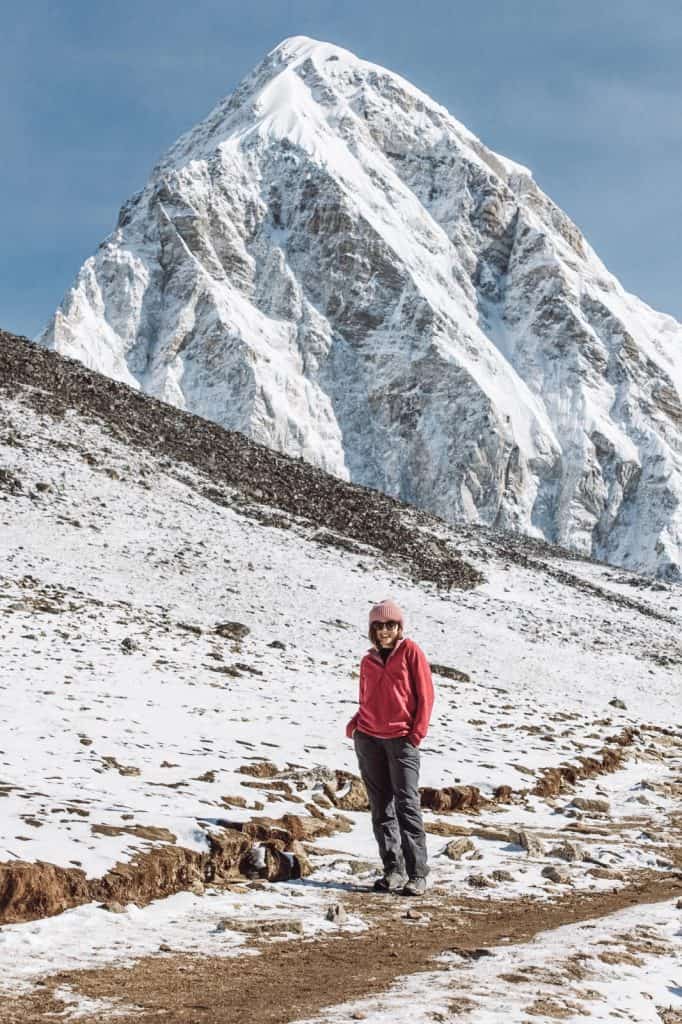
Why you need training for Everest Base Camp
Everest Base Camp is a physically challenging trek that requires you to hike daily for at least 11 days. Whilst it doesn’t require mountaineering or technical skills, it does reach an altitude of 17,600 feet. At this altitude, oxygen in the atmosphere is depleted and many people will experience altitude sickness. If you want to avoid altitude sickness, and potentially being helicoptered down the mountain before you reach base camp, then you need to train!
Related: Everest Base Camp Trek Diary: What it’s Really Like to Trek to Base Camp
7 things to include in your Everest Base Camp training plan
To best prepare your body for Everest Base Camp, and help prevent altitude sickness, then there are some important things to include in your Everest Base Camp training plan. Consider these the “pillars” of training. Even if you consider yourself physically fit, trekking Everest Base Camp requires a separate set of skills. My free 8-week Everest Base Camp training plan is designed with these training pillars in mind. Below, read about why and how each one is important!
1. Cardiovascular training
Improving your cardiovascular fitness is step one in training for Everest Base Camp. What is cardiovascular training? Any exercise that increases your heart rate and increases the strength of your cardiovascular system (heart, circulation, lungs). What is the benefit of cardiovascular training for Everest Base Camp? Cardiovascular training improves the efficiency of oxygen transport in the body. Due to high altitude/low oxygen conditions, your body is going to fatigue much sooner. By improving your body’s oxygen you will be able to trek longer, harder, and happier! You’ll also reduce your risk of altitude sickness.
Examples of cardiovascular training to include are high intensity interval training (HIIT) and running. There are other ways to improve cardiovascular fitness but I recommend focusing on exercises that are functionally similar to trekking. My 8-week Everest Base Camp training plan includes three days of cardio each week.
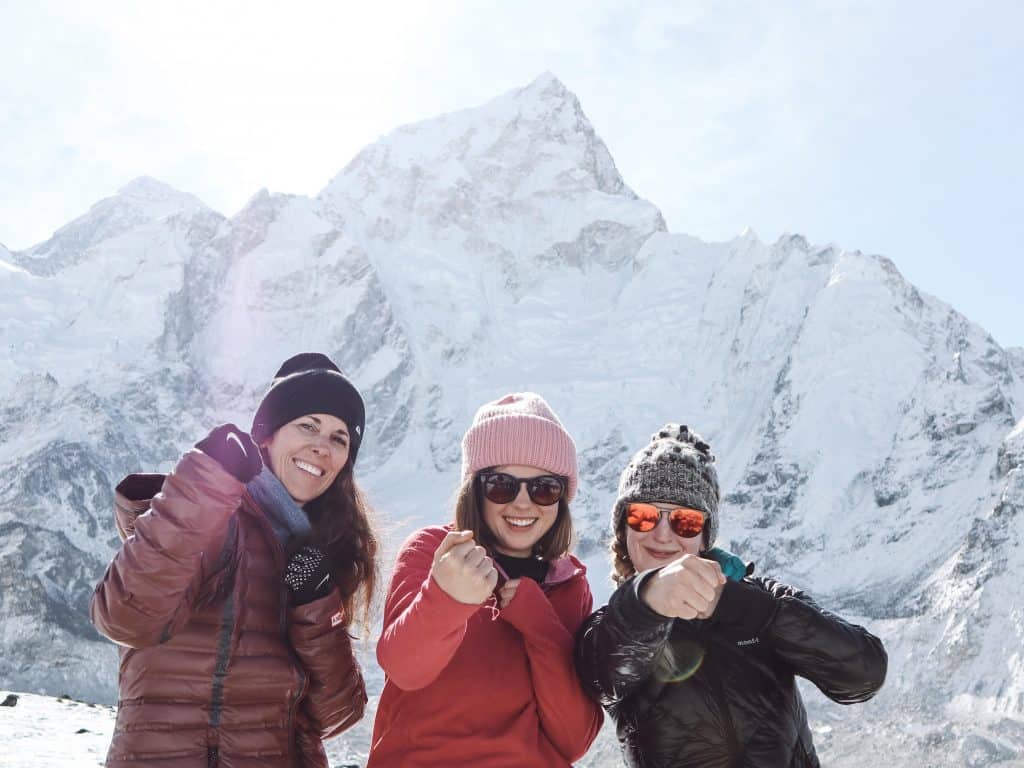
2. Strength training
In order to trek to 17,600 feet (and back down), you’re going to need a lot of strength in your legs, core, back, shoulders, and upper body. What is strength training? Any exercise that increases muscular strength, particularly exercise using resistance (resistance bands, dumbell weights, body-weight). What is the benefit of strength training for Everest Base Camp? You will need a lot of muscle strength to power you up the Himalayas. Your quads, glutes, hamstrings, calves, and ankle stabilizing muscles need to be strong for the trekking. In addition, you’ll need core strength to stabilize you, back and shoulder strength to carry your pack for hours, and general upper body strength for using your trekking poles.
Examples of strength training to include are free weights and body weight exercises. You should focus on full-body strength training, including lunges, squats, bench presses, push ups, lateral raises, bicep curls, tricep dips, and more. Don’t forget your upper body! If you are not familiar with strength training, I recommend joining a class or getting a session with a personal trainer, to help you avoid injury. My 8-week Everest Base Camp training plan includes 1-3 days of strength training each week.
Related: Nepal Gluten Free Guide
3. Endurance training
Often confused with cardiovascular training, endurance training is actually a distinct skill and equally important for Everest Base Camp training. What is endurance training? Any exercise that increases your ability to endure exercise for longer, harder, or faster. What is the benefit of endurance training for Everest Base Camp? Your body will be better prepared to not only trek 4-8 hours per day, but 11 days in a row. Endurance is two-fold: General endurance and specific endurance. For example, you can train to cycle for 200 miles, but this won’t necessarily transfer to your ability to endure 200 miles of trekking. That’s why endurance training should focus on functional exercises that are similar to your end goal.
Examples of specific endurance training to include are practice hikes and stair climbing (ascending and descending). My 8-week Everest Base Camp training plan includes 1-2 days of endurance training per week. In particular, you will build up your time on the stair climber, which will help immensely on the EBC trek.

4. Breath control
Yes, you should include breath control in your Everest Base Camp training plan! What is breath control? Your ability to regulate your breathing – especially diaphragmatic breathing. What is the benefit of breath control training for Everest Base Camp? Improving your breath control will enable you to breathe in a high altitude/low oxygen environment. By increasing your oxygen intake, you’ll be able to trek harder for longer. Unfortunately, breath control is often overlooked in Everest Base Camp training as it is not an “exercise” in and of itself.
Examples of breath control training to include are yoga and swimming. As far as exercise goes, these are the two best methods of improving breath control as both emphasize matching movement with inhales/exhales. Outside of exercise, activities like singing, playing a wind instrument, or just learning diaphragmatic breathing will help. My 8-week Everest Base Camp training plan includes one day of yoga each week.
5. Practice hikes
Truly one of the best ways to prepare for the Everest Base Camp trek is to do training hikes. What counts as a training hike? Any outdoor hike, preferably wearing your hiking boots and trekking socks. Bonus if the hike is at least five miles, and at least 1,500 feet altitude change (this mimics the minimum daily hike in the Everest Base Camp trek itinerary). What is the benefit of practice hikes for Everest Base Camp? Not only will you break in your gear, but you’ll be using the exact muscles you’ll need during the trek.
Try to include weekly hikes throughout training, and consecutive days of tough hikes in your final 2-3 weeks of training. What sets Everest Base Camp apart is that you will be doing a tough hike – 12 days in a row. Practicing consecutive hiking will help you build the right muscles and reduce soreness on your actual trek. You may even want to plan a long weekend or 2-4 day getaway in your last few weeks of training, so that you can experience consecutive hiking. NOTE: Although recommended, practice hikes are not necessary and there are still ways to train without them. Hiking is not accessible to everyone who is training for Everest Base Camp (depending on geographical location and season). My 8-week Everest Base Camp training plan is appropriate for EVERYONE and does NOT include practice hikes. However, information is given on when and how to include practice hikes in the plan, if they are accessible to you.
Related: 11-Day Everest Base Camp Trek Itinerary

6. Mental strength
I’ll come out and say it: Mental strength is so much more important than physical strength when it comes to the Everest Base Camp trek. You may not be the most physically fit, but if you have determination then you can do this trek! What is mental strength? Determination, confidence, perseverance, the ability to keep going! What is the benefit of mental strength for Everest Base Camp? This trek will push you to your very edge – from freezing nights, lack of showers, unending hills, potential sickness, blisters, and more. Don’t get me wrong… it’s glorious, too. And you’ll want to use the glory and beauty of the Himalayas around you to propel yourself down the trail.
There aren’t really examples of how to build mental strength – this is something personal that will come from within you. Personally, long distance running and hour-long stints on the stair climber helped build my mental strength in relation to physical endurance. Psychologically and spiritually, you should find a reason you are doing this trek. Once you know your personal why, you can come back to this in times when you want to quit.
Related: 25 Photos to Inspire You to Trek Everest Base Camp
7. Optional: Altitude gym or mask
Even if you don’t live in a high altitude environment, you can still simulate one with an “artificial environment.” These could be an altitude gym, or even an altitude simulation mask. What is an altitude gym? A gym that has been designed to mimic high altitude environments, by injecting nitrogen and reducing oxygen in the room’s atmosphere. Training in an altitude gym will give you a feeling of being at high altitude – you may be shorter of breath, feel like you have to work harder, and if you are using an oximeter (which I recommend) you’ll see your O2 sats lower. What is the benefit of altitude training for Everest Base Camp? Altitude training is said to improve oxygen transport, red blood cell volume, and VO2 max. All of these will enhance your ability to breathe and exercise in the Himalayas’ high altitude/low oxygen environment.
Why is this optional? Altitude gyms can be hard to find, so if there is not one in your area, then don’t worry about it (you can alternatively purchase an altitude simulation mask). Keep in mind, there is also limited research on the exact benefits of altitude gyms and masks, and therefore lack of a specific training protocol. The best proven altitude training program is called “Live High Train Low” (LHTL). To simulate LHTL, it is recommended to sleep in an altitude gym for 1-3 weeks prior to your trek. Obviously this is not accessible to many people! Despite this, altitude gyms are still useful as a way to prepare you mentally for the feeling of high altitude, and to help you practice breathing in this environment. Personally, I only went to an altitude gym once (Peabody Ice Climbing for anyone in Michigan), but it still helped an immense amount in learning how my body was going to react to low oxygen in Nepal. My 8-week Everest Base Camp training plan includes strategically designated optional altitude gym days.
Related: Trekking in Nepal: Ethics and Etiquette Considerations
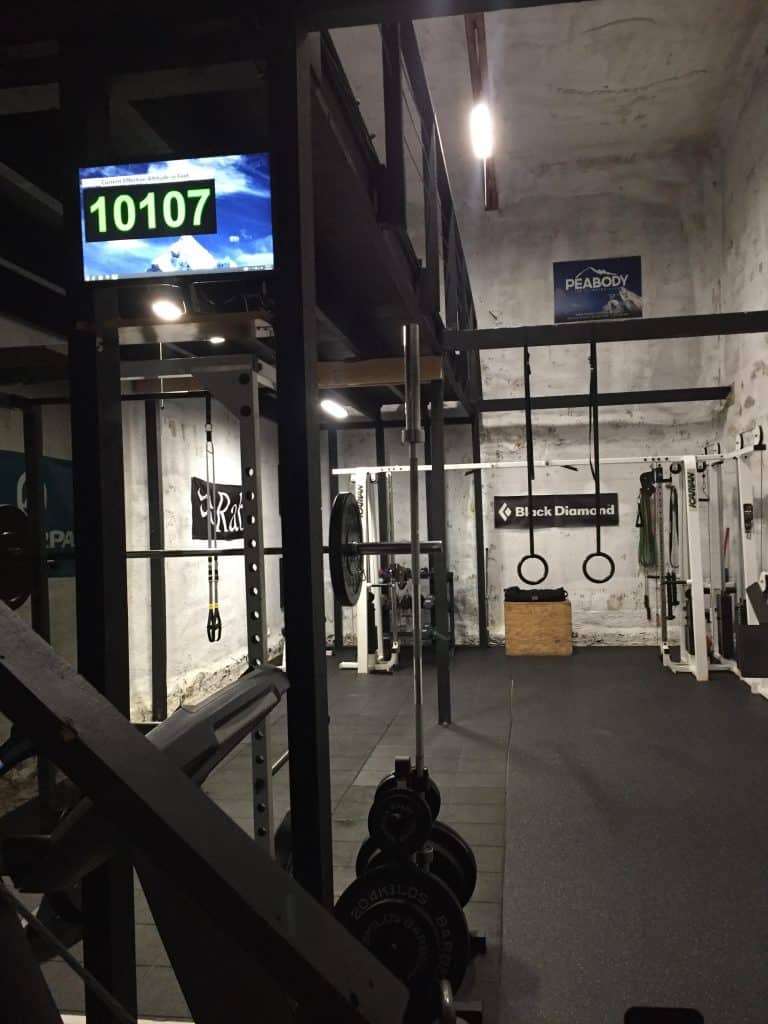
How long should your Everest Base Camp training last?
The most common recommendation is 3-6 months of training. That seems like a lot! Personally, I planned to train for 3 months prior to my Everest Base Camp trek. I ended up getting the flu for a month, so in the end I only had 8 weeks to train. I designed my 8-week Everest Base Camp training plan to help me through that reduced training period, and guess what… it worked! Keep in mind also that I trained at sea level, and in winter, too! By committing to an 8-week training plan I was able to trek Everest Base Camp in good health, without getting altitude sickness, and felt completely physically prepared.
You should consider your base level of fitness, your previous hiking/trekking experience, and how much time you have to commit. The length of Everest Base Camp training is ultimately a personal decision.
Free 8-week Everest Base Camp training plan
Sign up to download my Everest Base Camp training plan. You’ll receive an email with my downloadable 13-page guide. Included are three printable training plans, appropriate for varying base fitness levels. Each plan is eight weeks long and will thoroughly prepare you for the trek! The guide also includes information, advice, and recommendations for each exercise.
Recommended gear for training for Everest Base Camp
- Oximeter
- Dumbbells
- Resistance bands
- Yoga mat – I recommend MandukaPROlite Yoga Mat. Mine has lasted for 6 years.
- Running shoes
- Hydrocolloid blister band aids
- Kinesio tape and guide to taping
- Travel friendly foam roller
- Hiking boots
- Trekking socks – I recommend Smartwool Trek and WrightsockCoolmesh
- Trekking poles
- Nalgene water bottle
- 3-L water bladder
- Day pack
- Probar Bolts
- High altitude simulation mask
My personal Everest Base Camp training: What helped the most?
To sum it up… what helped me the most when I was doing my Everest Base Camp training? The long runs (my longest was only 7 miles, though) and weekly stair climber sessions were integral. I only went to an altitude gym once, but that helped prepare me mentally. I took a weekly interval training class with my dad which also helped. Coming from Michigan, and training in January/February, I didn’t do much outdoor hiking, which concerned me. However, I think the extreme cold temperatures did prepare me for conditions in the Himalayas. Additionally, I did a three-day trip to the Lake District in England, a week before leaving for Nepal. We did three consecutive days of hiking (and oh, I was so sore!), but this prepared me for EBC as I overcame my soreness from consecutive hikes (I recommend a mini travel foam roller during the trek to combat this!).
And obviously, creating and following my 8-week training plan was what kept me accountable. I printed it out, referred to it daily, and crossed off each day as it occurred. Whether you use my free training plan or not, I highly recommend having some kind of program to follow.
Check out my other Everest Base Camp trek posts…
- 11-Day Everest Base Camp trek itinerary
- Everest Base Camp trek video
- Everest Base Camp trek diary
- Ethics and etiquette for trekking in Nepal
- Nepal gluten free guide
- 25 photos to inspire you to trek Everest Base Camp
- Kathmandu travel impressions
Best of luck, future EBC trekkers! Any questions? Just leave a comment below.
Sarah xx
Pin it for later…
*Some links in this post are affiliate links.
*Disclaimer: I am a certified yoga instructor and health professional. I am not a personal trainer. I designed this training plan based on my own experience, education, and research. However I do not take any responsibility for the results of this plan – every person is unique and will respond to exercise differently. I encourage you to consult with a personal trainer or medical professional who is familiar with your own unique needs.


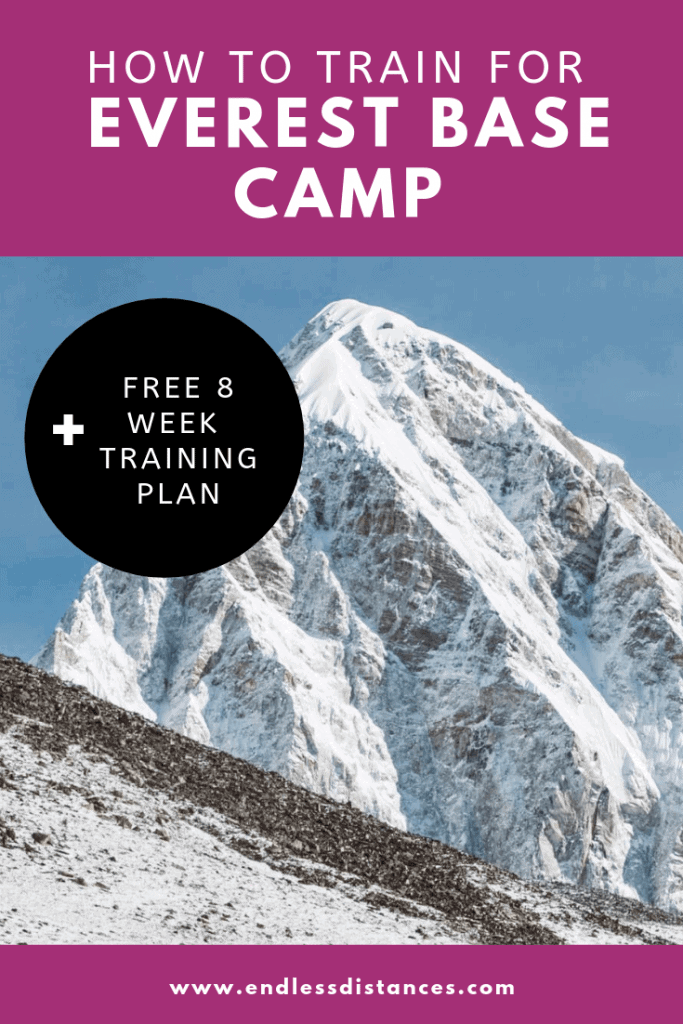
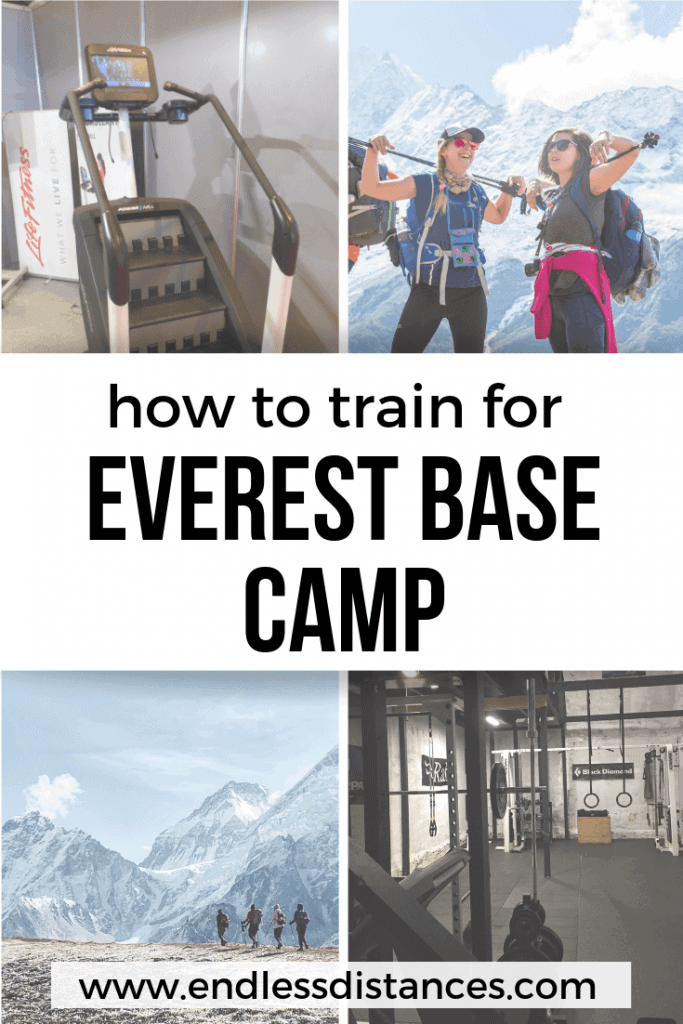
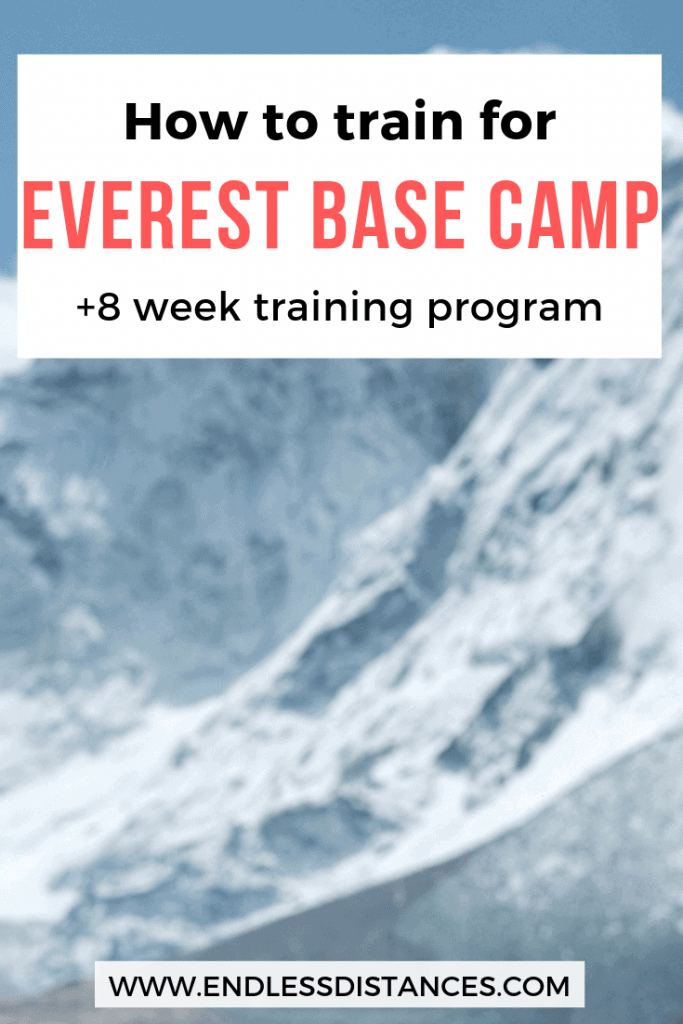
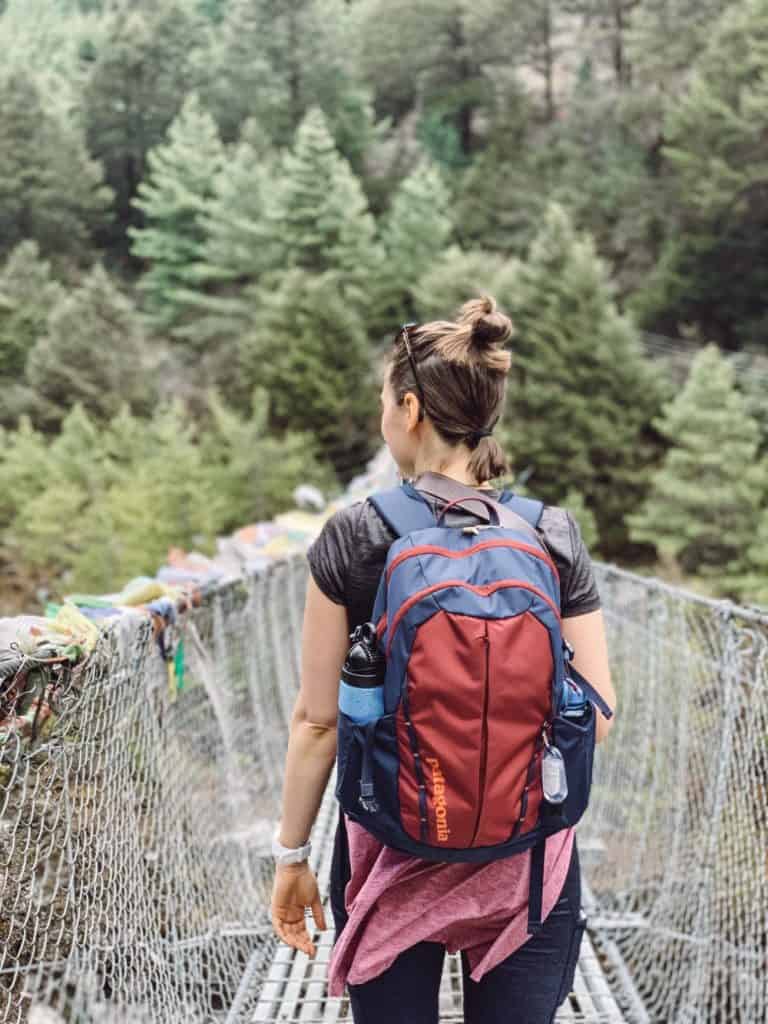
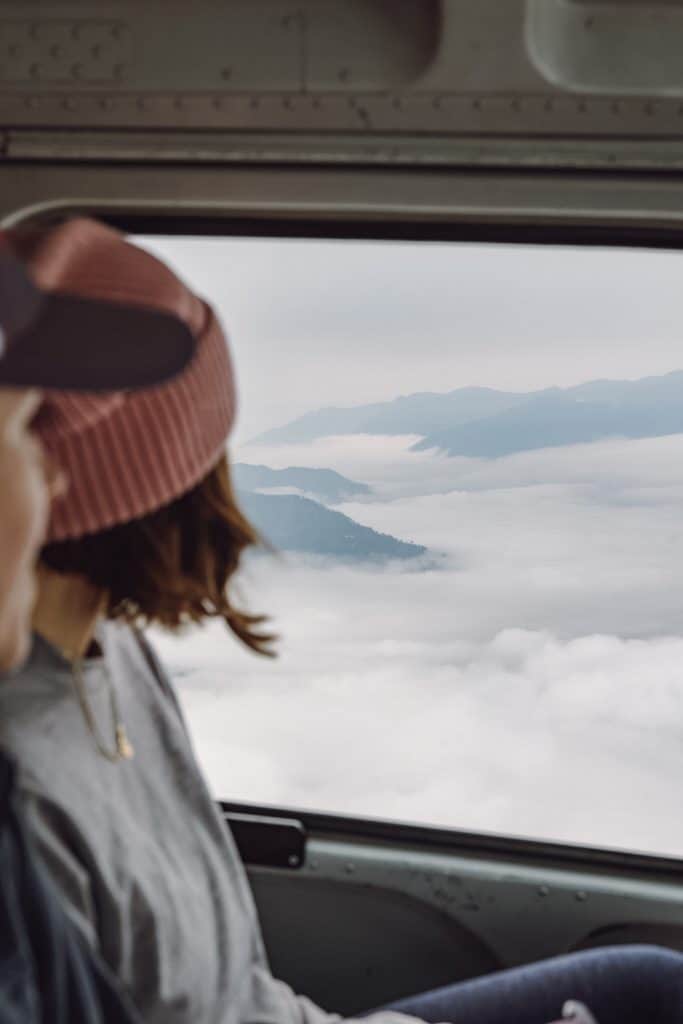
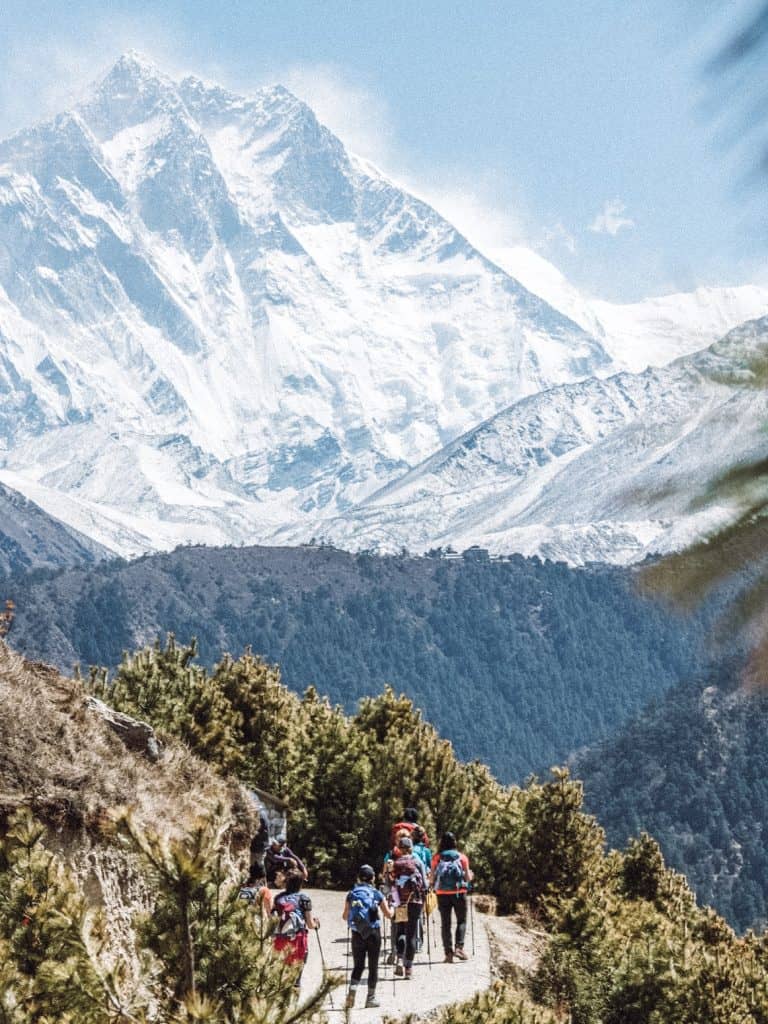
Very Practical and informative Guide and friend
Hi! I am training for Annapurna Base Camp and have 3 months. I’m grateful for this training plan, as I think it’ll get me into perfect shape! I was wondering if I an swap an elliptical for a stairmaster. I have an elliptical and a peloton, so I’d love to work them in!
Ohh, exciting! Good luck! I’m hoping to return to Nepal to do the Annapurna Circuit in a couple years. My friend did ABC right after we did EBC together and she loved it! I think you could swap the stairmaster for an elliptical (don’t those have “stair climb” settings usually?). If you do that, you might want to add in a few times of climbing stairs/bleachers outdoors and/or a steep hike just to gauge how you’re doing in that regard. I’m not totally sure how an elliptical will transfer over to the functional movement pattern of long ascents. And the peloton will be amazing for cross training!
Thank you! We live in Colorado, so we’re planning to do a 5 to 8 mile hike (with elevation gain) every weekend. We will start with 5 miles and 1000′ elevation gain… and then go up from there. I hope those hikes will make up for the lack of a stairmaster!